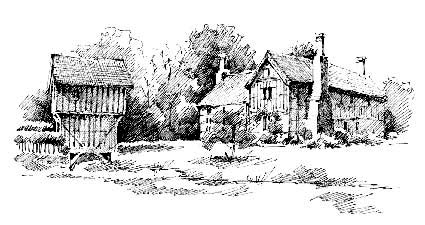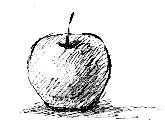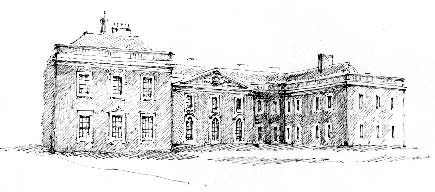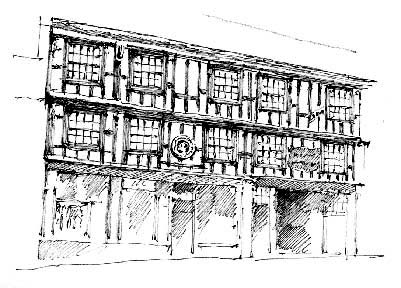Herefordshire
CIDER COUNTRY ∗ MEMBER FOR CIDER
∗ BIGGEST VAT ∗ WASSAILING
Lower Brockhampton House, a picturesque 14th-century moated manor house where time stands still.
HEREFORDSHIRE FOLK
John Kyrle ∗ Albert Gamage ∗ Beryl Reid ∗ John Blashford-Snell
England’s Cider Barrel
Herefordshire produces over half of England’s cider. It is Cider Country, and has been ever since the first VISCOUNT SCUDAMORE planted a REDSTREAK apple pip in his garden at HOLME LACY, near Hereford, in 1639.
Viscount Scudamore brought the pip back from France, where he had been Charles I’s ambassador in Paris. He had taken a keen interest in orchards and cider-making while on the Continent, and it seemed to him that cider was something that could be produced profitably when other forms of agriculture were in the doldrums. The rich red soil of Herefordshire is ideal for growing apples, and his Redstreak orchard flourished. Soon others in Herefordshire were copying his lead, until a commentator was moved to write, ‘Following the noble example of my Lord Scudamore, and some other spirited gentlemen in those parts, all Herefordshire is become in a manner but one entire orchard.’
Viscount Scudamore was an ardent Royalist, and was captured and imprisoned for four years during the Civil War. On his release he retired to Holme Lacy (rebuilt at the end of the 17th century into Herefordshire’s largest house, and now a hotel) and concentrated on building up his orchards. During this time he made the first sparkling cider by bottling it while it was still fermenting.
Over the next 100 years cider grew rapidly in popularity and became the national drink, until in 1763 the Prime Minister Lord Bute decided to levy a tax on it. The Cider Tax made other forms of agriculture suddenly more profitable and cider-making once more became a local industry in Herefordshire, with farmers just producing enough for their own families and workers.
Much Marcle
The next champion of Herefordshire cider was the MP for Hereford, C.W. RADCLIFFE-COOKE, of Hellens in Much Marcle – which sounds like somewhere Miss Marple might live. It is a beautiful place, especially in spring when the blossoms fill the senses and thoughts turn to a refreshing glass of Herefordshire cider. Radcliffe-Cooke suggested to his next-door neighbour, a Much Marcle farmer called HENRY WESTON, that Weston should try to market his cider commercially, and the MP even introduced WESTON’S CIDER into the bar at the House of Commons. So enthusiastic was his support for the product of his native county that he became known as the ‘Member for Cider’.
Weston’s Cider became so popular that Henry Weston had to plant hundreds more trees, build bigger vats and take on many more workers, Today, Weston’s is still family run, and has employed many generations of local people. The cider market is today robust enough to support some 20 cider-makers of varying size in Herefordshire.
The largest of the Herefordshire cider-makers is BULMERS, which was started by Percy Bulmer, youngest son of the Rector of Credenhill, north of Hereford, in 1887, when he began producing cider from his father’s orchard. Bulmers is now THE BIGGEST CIDER-MAKER IN THE WORLD and the Bulmers STRONGBOW VAT is THE LARGEST ALCOHOLIC CONTAINER IN THE WORLD, with a capacity of 15 million gallons (68 million litres).
The earliest written mention of cider found so far comes from the 15th century, in the Wycliffe ‘Cider Bible’ kept in THE LARGEST CHAINED LIBRARY IN THE WORLD in Hereford Cathedral. The word cider, spelt ‘sidir’, is used where other bibles say strong drink, in the passage about John the Baptist: ‘For he shall be great in the sight of the Lord, and shall drink neither wine nor sidir . . .’
Wassailing
The cider-makers of Herefordshire still observe the ancient tradition of WASSAILING on the evening of Twelfth Night, when the farmers and their families, workers and friends gather in the orchards to celebrate the goddess Pomona and encourage a bountiful crop. Armed with sticks and a bowl of cider with bits of toast in it, they congregate around the best tree in the orchard and place a piece of toast in the branches to attract birds. They then drink some of the cider and pour the rest on the tree roots, while dancing round the trunk and beating at the base with their sticks, dislodging insects, which the birds, attracted by the toast, swoop down and eat. Wassailing songs are sung throughout. Wassail comes from the Anglo-Saxon ‘was hal’, meaning good health.
Well, I never  knew this
knew this
about
HEREFORDSHIRE FOLK
John Kyrle
1637–1724
ROSS-ON-WYE sits perched on a rocky outcrop above the River Wye, and owes much of its handsome appearance to a generous 17th-century benefactor called JOHN KYRLE, immortalised by Alexander Pope as ‘THE MAN OF ROSS’. Kyrle provided the town with its first water supply, pumped up from the river to standpipes in the street, rebuilt the lovely church spire, adding 50 ft (15.2 m) to its height, which is now 208 ft (63 m), and gave the sonorous tenor bell which rings out across the town from the bell tower. He donated the Prospect Gardens, with their far-reaching views over the river valley and into Wales, and built a causeway across the flood meadows. When he died, aged 87, he was laid in state in the church for nine days, and the whole town came out to pay their respects. His home, Kyrle House, is still standing in the Market Place, and is now occupied by a shop and the local newspaper’s offices.
Kyrle House
Born in Hereford
ALBERT GAMAGE (1855–1930), founder in 1878 of Gamages store in Holborn, London.
BERYL REID (1919–96), comedy actress.
JOHN BLASHFORD-SNELL, explorer, born 1936. Made the first descent of the Blue Nile in 1968 and the first crossing by vehicle of the Darien Gap between Central and South America in 1972.








 knew this
knew this